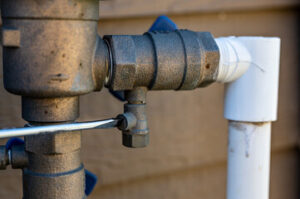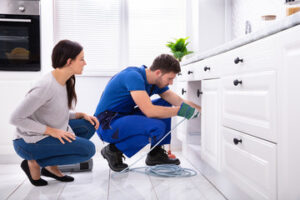Plumbers Near Me are responsible for the installation, maintenance, and troubleshooting of plumbing systems. These include water supply lines, drains, sewer systems, and fixtures like toilets and faucets.

They also work on larger scale plumbing in commercial and industrial buildings. This includes systems that serve a large number of people and are connected to larger industrial equipment.
A drippy faucet is not only annoying but it can waste gallons of water every day. If you ignore a leaky faucet it could result in extensive damage to your home. It is important to know that fixing a leaky faucet is easier than you think and it can save you money in the long run.
The first step in repairing a leaky faucet is to turn off the water supply. This can be done by closing the valve under the sink or turning off the main water line to your house. Make sure to turn off the water completely and not just a trickle so you don’t flood your bathroom or cause more damage in the future.
Next, you will need to have some tools on hand such as a flathead screwdriver and a pair of pliers. You will also need a small bowl of distilled white vinegar and a clean rag to clean any mineral deposits on the faucet parts. Before you start working, it is a good idea to duct tape the jaws of your pliers to prevent them from damaging the faucet. It is also a good idea to mark or take pictures of the different faucet parts before you remove them so you can put them back in the right order when it is time to reassemble.
If you have a single handle faucet then you will need to remove the decorative cap and unscrew the screw that holds the handle in place. This should come off fairly easily, but if it does not then you may need to use some penetrating oil to break up any rust or sediment in the threads of the screw. Once the screw is removed you will be able to pull off the handle and then you can start to replace the parts.
First, you will need to remove the valve seat washer, which is located underneath the stem and gets compressed by the handle when it is closed. This part can get corroded over time and is often the cause of a leaky faucet. You will need to replace this washer with a new one and make sure it is the same size as the old one. It is also a good idea to coat the new washer with some nontoxic plumber’s grease so it does not wear out as quickly.
Replacement of the Seat Washer
The seat washer sits atop a screw at the base of the faucet and provides an important function: keeping water flowing freely. Over time, the washer can wear out, leading to leaks. Replacing the washer is an inexpensive and effective alternative to replacing the entire faucet.
Plumbers install, repair and maintain pipes that carry water and waste to and from homes and businesses. They also install and fix plumbing fixtures, such as bathtubs, sinks, toilets and showers. They may also work on gas lines. Plumbers must be able to read blueprints and understand the theory behind plumbing systems. They often use hand tools, power tools and diagnostic equipment.
Most states require plumbers to be licensed. They must pass an exam that tests their knowledge of the trade and local laws and regulations. Plumbers can also choose to obtain certifications in specific areas of expertise, such as working with certain types of equipment or green plumbing practices.
As the demand for plumbers continues to grow, so does the need for qualified applicants. There are many benefits of becoming a plumber, including a competitive salary and job security. However, the career requires a great deal of physical labor and stamina, as well as the ability to follow strict safety protocols.
The minimum education requirement to become a plumber is a high school diploma or equivalent. Many vocational schools and community colleges offer courses in plumbing, and students can also pursue an apprenticeship to learn the trade. After completing their training, most states require plumbers to pass an exam and earn a license before they can begin their careers. In addition, some cities and counties have additional requirements for plumbers, such as requiring continuing education or experience. New York City, for example, requires master plumbers to complete seven hours of continuing education before they can renew their licenses. Other cities, such as Ithaca and Onondaga County, do not require plumbers to be licensed but expect them to stay up-to-date on the latest plumbing codes and regulations.
Replacement of the O-Ring
O-rings are found in a huge variety of machinery, equipment and devices that make modern civilization function. They’re used as a seal to connect components in mechanical applications and provide a waterproof connection. In order for O-rings to do their jobs, they must be free of foreign substances and lubricated to improve their functionality. When they don’t function properly, leaks can occur. The best way to prevent this from happening is by regularly checking the O-ring and making sure that it isn’t damaged or deteriorated.
Damaged o-rings are usually easy to spot. When an O-ring is damaged, it develops a circle of circumferential splits on its flattened surface, which is caused by excessive compression. It may also display blisters or pockmarks on its surface, which is often the result of rapid pressure changes. If it shows signs of a loss in elasticity, which happens when an O-ring becomes hard, it should be replaced immediately to prevent it from breaking down further.
When replacing an O-ring, it’s important to ensure that you’re using the correct size. It’s recommended that you measure the O-ring’s inner diameter (ID), outer diameter (OD) and cross-section with a caliper or ruler before purchasing a replacement. The wrong size o-ring can cause leaks, so it’s vital that you make the right measurement.
Once you’ve purchased the correct O-ring, it’s time to install it. First, remove the old O-ring from its groove and clean the area to ensure it’s smooth. Then, use an o-ring pick or other tool to carefully place the new O-ring in its groove. It’s important to not twist or pinch the O-ring when installing it because doing so can cause it to crack and lose its sealing ability.
Choosing the correct O-ring material is also important because different materials are suited to different applications. Silicone, for example, is a popular choice in a wide range of temperature conditions and offers resistance to oxidation, fungal growth and many chemicals. EPDM is another common O-ring material that offers a high level of heat resistance and good chemical compatibility, while PTFE is an excellent option in systems that are exposed to steam, silicone or grease.
Replacement of the Handle
Plumbers are responsible for installing and repairing pipes that supply water and carry waste away from homes and businesses. They also work on a variety of plumbing fixtures, such as toilets, bathtubs, showers, sinks, and faucets. In addition to these basic tasks, they may also install and repair gas lines and septic systems. Plumbers must be competent at using a variety of tools and have excellent problem-solving skills. They must also be able to read and interpret blueprints and construction plans. Plumbers often work in uncomfortable and tight spaces, so they should be physically fit and comfortable with these conditions.
Some plumbers are self-employed contractors who work independently, while others work for large companies or organizations. Regardless of their employment status, most plumbers must pass an exam to become licensed in their state. To prepare for this exam, plumbers should attend a vocational school or community college that offers courses in the plumbing trade. They should also complete an apprenticeship to learn the trade through hands-on experience.
A high school diploma is typically the minimum educational requirement to become a plumber. However, many plumbers earn a bachelor’s degree in the field to improve their chances of finding employment or getting promoted within their company. Additional qualifications include a strong background in mathematics, physical science, and social sciences. Additionally, plumbers must be able to solve complex problems and think quickly under pressure.
A career as a plumber can be rewarding, as it allows you to help people with their plumbing needs and gain useful skills that will last a lifetime. In addition, the demand for plumbers remains consistent, so you can enjoy a stable and secure job with good earning potential. However, the plumbing industry is not without its challenges, including working in cramped spaces and dealing with hazardous materials. For these reasons, it is important to weigh the pros and cons of a career in plumbing before making your decision.
Plumbers are responsible for the installation, maintenance, and troubleshooting of plumbing systems. These include water supply lines, drains, sewer systems, and fixtures like toilets and faucets.
They also work on larger scale plumbing in commercial and industrial buildings. This includes systems that serve a large number of people and are connected to larger industrial equipment.
A drippy faucet is not only annoying but it can waste gallons of water every day. If you ignore a leaky faucet it could result in extensive damage to your home. It is important to know that fixing a leaky faucet is easier than you think and it can save you money in the long run.
The first step in repairing a leaky faucet is to turn off the water supply. This can be done by closing the valve under the sink or turning off the main water line to your house. Make sure to turn off the water completely and not just a trickle so you don’t flood your bathroom or cause more damage in the future.
Next, you will need to have some tools on hand such as a flathead screwdriver and a pair of pliers. You will also need a small bowl of distilled white vinegar and a clean rag to clean any mineral deposits on the faucet parts. Before you start working, it is a good idea to duct tape the jaws of your pliers to prevent them from damaging the faucet. It is also a good idea to mark or take pictures of the different faucet parts before you remove them so you can put them back in the right order when it is time to reassemble.
If you have a single handle faucet then you will need to remove the decorative cap and unscrew the screw that holds the handle in place. This should come off fairly easily, but if it does not then you may need to use some penetrating oil to break up any rust or sediment in the threads of the screw. Once the screw is removed you will be able to pull off the handle and then you can start to replace the parts.
First, you will need to remove the valve seat washer, which is located underneath the stem and gets compressed by the handle when it is closed. This part can get corroded over time and is often the cause of a leaky faucet. You will need to replace this washer with a new one and make sure it is the same size as the old one. It is also a good idea to coat the new washer with some nontoxic plumber’s grease so it does not wear out as quickly.
Replacement of the Seat Washer
The seat washer sits atop a screw at the base of the faucet and provides an important function: keeping water flowing freely. Over time, the washer can wear out, leading to leaks. Replacing the washer is an inexpensive and effective alternative to replacing the entire faucet.
Plumbers install, repair and maintain pipes that carry water and waste to and from homes and businesses. They also install and fix plumbing fixtures, such as bathtubs, sinks, toilets and showers. They may also work on gas lines. Plumbers must be able to read blueprints and understand the theory behind plumbing systems. They often use hand tools, power tools and diagnostic equipment.
Most states require plumbers to be licensed. They must pass an exam that tests their knowledge of the trade and local laws and regulations. Plumbers can also choose to obtain certifications in specific areas of expertise, such as working with certain types of equipment or green plumbing practices.
As the demand for plumbers continues to grow, so does the need for qualified applicants. There are many benefits of becoming a plumber, including a competitive salary and job security. However, the career requires a great deal of physical labor and stamina, as well as the ability to follow strict safety protocols.
The minimum education requirement to become a plumber is a high school diploma or equivalent. Many vocational schools and community colleges offer courses in plumbing, and students can also pursue an apprenticeship to learn the trade. After completing their training, most states require plumbers to pass an exam and earn a license before they can begin their careers. In addition, some cities and counties have additional requirements for plumbers, such as requiring continuing education or experience. New York City, for example, requires master plumbers to complete seven hours of continuing education before they can renew their licenses. Other cities, such as Ithaca and Onondaga County, do not require plumbers to be licensed but expect them to stay up-to-date on the latest plumbing codes and regulations.
Replacement of the O-Ring
O-rings are found in a huge variety of machinery, equipment and devices that make modern civilization function. They’re used as a seal to connect components in mechanical applications and provide a waterproof connection. In order for O-rings to do their jobs, they must be free of foreign substances and lubricated to improve their functionality. When they don’t function properly, leaks can occur. The best way to prevent this from happening is by regularly checking the O-ring and making sure that it isn’t damaged or deteriorated.
Damaged o-rings are usually easy to spot. When an O-ring is damaged, it develops a circle of circumferential splits on its flattened surface, which is caused by excessive compression. It may also display blisters or pockmarks on its surface, which is often the result of rapid pressure changes. If it shows signs of a loss in elasticity, which happens when an O-ring becomes hard, it should be replaced immediately to prevent it from breaking down further.
When replacing an O-ring, it’s important to ensure that you’re using the correct size. It’s recommended that you measure the O-ring’s inner diameter (ID), outer diameter (OD) and cross-section with a caliper or ruler before purchasing a replacement. The wrong size o-ring can cause leaks, so it’s vital that you make the right measurement.
Once you’ve purchased the correct O-ring, it’s time to install it. First, remove the old O-ring from its groove and clean the area to ensure it’s smooth. Then, use an o-ring pick or other tool to carefully place the new O-ring in its groove. It’s important to not twist or pinch the O-ring when installing it because doing so can cause it to crack and lose its sealing ability.
Choosing the correct O-ring material is also important because different materials are suited to different applications. Silicone, for example, is a popular choice in a wide range of temperature conditions and offers resistance to oxidation, fungal growth and many chemicals. EPDM is another common O-ring material that offers a high level of heat resistance and good chemical compatibility, while PTFE is an excellent option in systems that are exposed to steam, silicone or grease.
Replacement of the Handle
Plumbers are responsible for installing and repairing pipes that supply water and carry waste away from homes and businesses. They also work on a variety of plumbing fixtures, such as toilets, bathtubs, showers, sinks, and faucets. In addition to these basic tasks, they may also install and repair gas lines and septic systems. Plumbers must be competent at using a variety of tools and have excellent problem-solving skills. They must also be able to read and interpret blueprints and construction plans. Plumbers often work in uncomfortable and tight spaces, so they should be physically fit and comfortable with these conditions.
Some plumbers are self-employed contractors who work independently, while others work for large companies or organizations. Regardless of their employment status, most plumbers must pass an exam to become licensed in their state. To prepare for this exam, plumbers should attend a vocational school or community college that offers courses in the plumbing trade. They should also complete an apprenticeship to learn the trade through hands-on experience.
A high school diploma is typically the minimum educational requirement to become a plumber. However, many plumbers earn a bachelor’s degree in the field to improve their chances of finding employment or getting promoted within their company. Additional qualifications include a strong background in mathematics, physical science, and social sciences. Additionally, plumbers must be able to solve complex problems and think quickly under pressure.
A career as a plumber can be rewarding, as it allows you to help people with their plumbing needs and gain useful skills that will last a lifetime. In addition, the demand for plumbers remains consistent, so you can enjoy a stable and secure job with good earning potential. However, the plumbing industry is not without its challenges, including working in cramped spaces and dealing with hazardous materials. For these reasons, it is important to weigh the pros and cons of a career in plumbing before making your decision.

